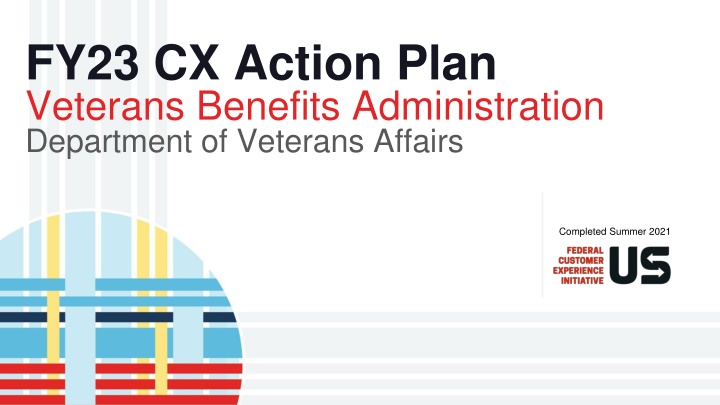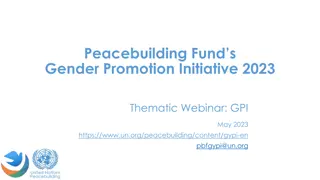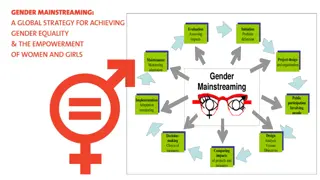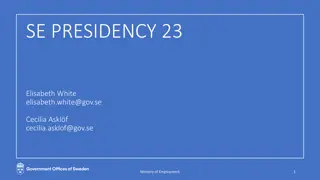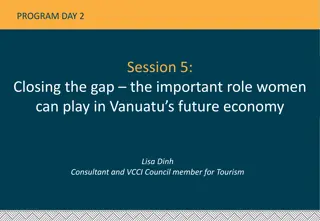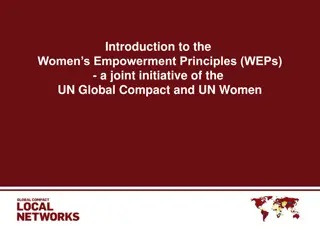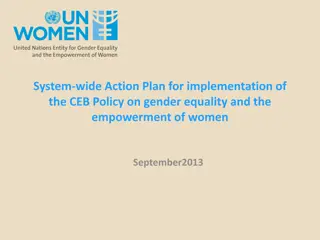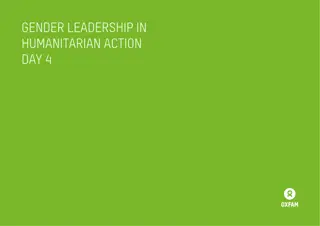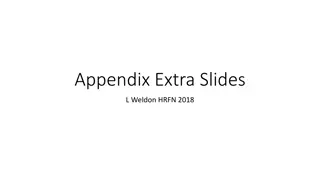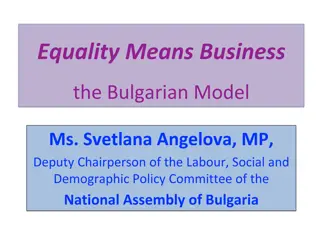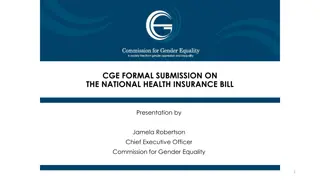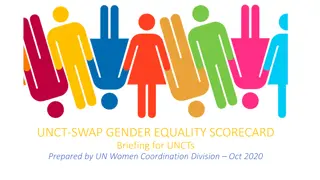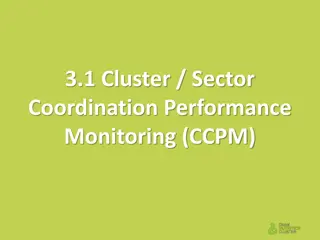Regional Training Workshop on Gender Equality and Women's Empowerment in Africa
Africa is implementing the 2030 Agenda and Agenda 2063 to achieve sustainable development and inclusive growth. The frameworks reflect African development priorities and aspirations, focusing on pillars like economic transformation, innovation, and environmental sustainability. The workshop aims to enhance data use for monitoring gender equality and women's empowerment in alignment with these agendas.
Download Presentation

Please find below an Image/Link to download the presentation.
The content on the website is provided AS IS for your information and personal use only. It may not be sold, licensed, or shared on other websites without obtaining consent from the author.If you encounter any issues during the download, it is possible that the publisher has removed the file from their server.
You are allowed to download the files provided on this website for personal or commercial use, subject to the condition that they are used lawfully. All files are the property of their respective owners.
The content on the website is provided AS IS for your information and personal use only. It may not be sold, licensed, or shared on other websites without obtaining consent from the author.
E N D
Presentation Transcript
FY23 CX Action Plan Veterans Benefits Administration Department of Veterans Affairs Completed Summer 2021
FY21 Capacity Assessment Reflection Summary What we re proud of this year: Customer Understanding & Service Design Journey Mapping: Efforts continued as outlined in VBA s 2019-2020 Customer Experience (CX) Action Plan; we capitalized on opportunities to innovate human-centered-design (HCD) research to accommodate an all-virtual approach for our Women Veterans Journey Map, delivered in April 2021. The communication plan is being developed to share journey map, insights, and personas with all VBA employees and key stakeholders to build empathy across all business lines when interacting with Women Veterans. In addition, we are using the insights from the journey map to prioritize potential solutions to help Women Veterans better navigate VA benefits in the coming year. We have also initiated efforts to map the journeys of Native American Veterans and Military Sexual Trauma survivors to better understand their experiences in accessing VA benefits so we can co-design solutions to address pain points for these populations of Veterans. In addition to mapping external customer experience, VBA participated in a VA-wide initiative led by the Veterans Experience Office (VEO) to deliver the first ever VA Employee Experience journey map. This product is being used to prioritize and implement initiatives targeted at improving the experience, tools, and training available to employees delivering services to Veterans across VA. Post-Separation Transition Assistance Program (PSTAP) assessment: VBA successfully delivered the first report to Congress on the PSTAP, which identified opportunities to improve experiences for two distinct cohorts of separating Service Members: African Americans Service Members and Service Members with a rank of E-4 or lower. We initiated HCD studies to better understand all factors contributing to lower overall life satisfaction for these two cohorts and are actively working with community partners to address opportunities to enhance a sense of connection. 2 Additional opportunities to improve customer understanding or service design identified through measurement of VA s pandemic response will be discussed in those respective sections.
FY21 Capacity Assessment Reflection Summary What we re proud of this year: Measurement Veterans Signals (VSignals): In partnership with VEO, VBA successfully launched all previously planned VSignals CX surveys this year. We have fully implemented standard CX surveys across all of VBA s call centers, including the VBA National Call Centers, Education Call Centers, and Insurance Call Centers as of October 2020. VBA's agility in quickly transitioning to a telework environment ensured continued availability and support during COVID. VBA s call centers have consistently garnered high ratings from Veterans and beneficiaries on employee helpfulness. VBA s Education Call Center has maintained above an 80% average rating in employee helpfulness over the past year. In July 2020, we implemented VSignals surveys to measure the experience of Veterans and beneficiaries with two additional services VBA offers: education benefits and decision review. For both processes, VBA implemented surveys at critical touchpoints to our customers. While we are in the initial baseline year with both efforts, we are actively using survey responses to identify areas for process improvement, to include: Education Benefits: Feedback from GI Bill participants is used to shape the GI Bill s modernization efforts, the Digital GI Bill. Therefore, we are putting beneficiaries and partners at the center of this new process and customer service platform. Decision Review: Feedback from Veterans indicated that the form used to select a lane in the newly implemented decision review process was lengthy and confusing. We used this feedback and HCD methods to revise and simplify the form to make it easier for Veterans to understand and easier for employees to process. Improvements include new sections for easier placement of claim information, clearer instructions, and simpler language. VBA also developed a lane selection tool to help the National Call Center and accredited representatives (VSOs and private attorneys) guide Veterans through the deliberative process to determine which AMA decision review lane is right for them. 3
FY21 Capacity Assessment Reflection Summary What we re proud of this year: Culture & Organization In VBA, we believe that to make a lasting impact in improving VBA s CX, we need to increase our internal capacity to work closer to the VBA workforce and supplement our partnership with VEO. We built a team to serve as an integrator to VBA for VEO efforts and successfully kicked off a CX Champion role within VBA, hosting a first of its kind virtual CX Symposium for approximately 80 employees from all of VBA s regional offices, district offices, staff offices, and business lines. We covered CX 101, as well as more advanced training in HCD, including journey mapping, persona development, and using CX data for action planning. We provided tools and templates to drive standardization in conjunction with VBA s executives CX improvement initiatives. We launched an ongoing community of practice (CoP) for CX Champions to continue enhancing their role in VBA CX. We will deliver a CX playbook for our Champions to use on projects at the local level this year and continue to support our Champions through the CoP. In FY2020, we trained over 280 VBA employees in CX basics and over 150 employees in more advanced HCD methods. We continue efforts to spread CX understanding across VBA. In addition, we piloted VEO s Own the Moment (OTM) training curriculum and are actively incorporating feedback from VBA employees to prepare for VBA-wide implementation plans in coming years. OTM is a training developed by VEO to help VA employees identify ways they can positively impact the Veteran Experience in their day-to-day jobs. This training, originally designed for VHA employees, is undergoing redesign for VBA. Where we need to do better: As identified in prior action plans, VBA is establishing nascent capabilities in CX measurement and transforming data from a variety of sources (operational, VSignals, and HCD) into insights that enable business lines to make a discernable change in CX for our Veterans. We are actively working with VEO to implement a multi-year roadmap designed to help us reach our goals. This roadmap includes robust efforts in CX data, tools, technology, and engagement. 4
Adapting Service During a Global Pandemic Where we innovated Our organization rapidly adjusted its way of doing business during the COVID-19 pandemic. We consulted with industry leaders to rework research plans and leveraged virtual technology to develop journey maps. We also increased telework options for employees in coordination with our Office of Information Technology (OIT), expanding the use of virtual counseling technology to parts of the organization that traditionally met with customers in person. To keep up with evolving needs, IT improved bandwidth for remote access and installed upgraded programs to facilitate remote collaboration. VBA seamlessly transitioned to a virtual environment and continued to provide benefits and services to Veterans while ensuring the safety and well- being of both Veterans and employees. The success in continuity of service to Veterans while operating in a mass telework environment stems from VBA s already flexible telework policy and a long-standing commitment to information technology modernization and digitization efforts. VBA kept feedback channels open for Veterans and assisted with the response to the COVID-19 pandemic: Education: Veterans receiving education assistance expressed concern that they would be unable to pay rent and continue studies since VBA, under existing rules, would reduce their housing allowances as classes shifted online. VBA quickly worked with Congress to resolve the issue and within two weeks, legislation passed that allowed Veterans to maintain their current level of housing payments during the crisis. Loan Guaranty Service (LGY): VBA s LGY assisted Veterans impacted by the pandemic with retaining their homes by providing financial assistance for missed mortgage payments. LGY also adapted policies and procedures to assist Veterans eligible for specially adapted housing, which provided home adaptations enabling these Veterans to live more independently. Insurance: Insurance Services response to COVID-19 improved services for customers by automating the main features Veterans and their beneficiaries use to access their policy information and apply for benefits. These new functionalities, such as instant loan approval and document upload, allow for quicker processing and faster disbursement of funds. Centralized Mail: VBA's Centralized Mail program was expanded to support additional business lines and enable telework at all regional offices. Throughout the pandemic, VBA's mail intake and scanning infrastructure remained fully online and digitized more than five million mail packets within six hours of receipt. This capability ensured VBA accounted for all inbound claims and was instrumental during the pandemic. VBA Social Media: VBA used social media to highlight services available to Veterans during the pandemic. These posts provide answers to frequently asked questions and promote online events where Veterans can ask VBA executives and staff members questions. These events help VBA to identify common questions and concerns that can be addressed through amended online guidance. 5
HISP Equity Reflection Who is this provider intended to serve? VBA is responsible for administering VA programs that provide financial or other forms of assistance to Veterans, their dependents, and survivors. Major benefits include Veterans' compensation, Veterans' pension, survivors' benefits, rehabilitation and employment assistance, education assistance, home loan guaranties, and life insurance coverage. Are there barriers that people of color, people with disabilities, LGBTQ+ people, women, non-native English speakers, and others who have been historically underserved, marginalized, discriminated, and adversely affected by persistent poverty and inequality face with regard to this program or service? How might these individuals interact with your program differently? VBA is aware that underserved communities are not always aware of their benefits and how to access them. Barriers include: Access to information Understanding correspondence and forms due to education level and language barriers Financial Education VBA currently employs additional targeted outreach, communications, and marketing designed to increase the number of Veterans using the benefits they have earned. Engagement measures include: The Outreach, Transition, and Economic Development program maintains national, state, and local partnerships that engage specific Veteran populations, such as minority, women, elderly, homeless, rural, faith-based, Native American, and incarcerated Veterans VA Solid Start program contacts all recently-separated Veterans within the first year after release from active duty to ensure they have access to and information about the benefits and services they have earned due to their service Veterans undergoing examination for Military Sexual Trauma will be given a choice of a male or female examiner Peer-to-peer network building through the Women s Veterans Coordinators located at regional offices Redesign correspondence and forms to improve ease of understanding Marketing of Loan/Financial Programs 6
HISP Equity Reflection (cont.) Where do we have a knowledge gap about individuals interactions with our services that we need evidence to fill? VBA, in partnership with VEO, is actively mapping journeys of specific populations of Veterans to fill knowledge gaps. As previously noted, insights from the Women Veterans Journey Map are being used to prioritize process improvement opportunities specific to women Veterans. Two more journey maps are currently in development: Native American Veterans and Military Sexual Trauma survivors. We anticipate these efforts will lead us to identify targeted follow-on projects that simplify processes, information, choice and/or access for these populations of Veterans as they interact with VBA. VBA is also researching information gaps in the action plan to address Executive Order 14008, which focuses on environmental justice for disadvantaged communities that have been historically marginalized and overburdened by pollution and underinvestment in housing. In addition to journey maps and targeted HCD efforts, VBA hosts a series of virtual Veterans Experience Action Centers in partnership with VEO. Because of feedback received from Native American Veterans and their advocates, VBA is establishing a dedicated team to help Native American Veterans with their home ownership needs, to include expanding outreach and assisting with loan processing and construction. 7
FY22-23 Commit to Action: Digital GI Bill What customer need will this action address? Education Service (EDU): Increased accuracy, efficiency, and timeliness of claims processing; greater ability to respond to new requirements and legislation; increased access to business analytics; increased employee satisfaction due to improved processes GI Bill beneficiaries: Enhanced ability to have real-time access to eligibility and enrollments; transparency into benefits used; better tools to support student and career planning; better access to U.S. Department of Veterans Affairs (VA), School Certifying Officials (SCOs), etc. Schools (SCO): Improved coordination between VA, schools, and students; ability to have real-time access to information such as remaining benefits and eligibility; ability to communicate digitally with stakeholders in an integrated platform Why is this a priority? VA is currently operating with disparate IT systems and manual processes that create inefficiencies in processing GI Bill claims, do not allow timely responsiveness to changes in legislation or policies, and lack comprehensive reporting and forecasting capabilities. Additionally, the current systems lack the ability to meet service expectations of GI Bill students, EDU employees, and external stakeholders (schools, State Approving Agencies, Veterans Service Organizations, Congress). 8 Who is responsible for this action happening? VBA s EDU, Office of Information & Technology (OIT), and Office of Business Integration (OBI) teams.
FY22-23 Commit to Action: Digital GI Bill What action(s) / deliverables / milestones will you take / hit between Oct. 1, 21 Sept. 30, 22? Increased automation processing and adjudication will be implemented for Chapter 33 claims by Oct 2021, followed by Non-Chapter 33 claims by October 2022. The GI Bill student landing page and My VA Benefits portal will go-live in December 2021; full rollout of the managed service and integrated IT hub to include the new Enrollment Manager application will go live by October 2022. How will you measure whether these actions had their intended effect? Claims processing: Number of claims processed; average time for processing claims; original and supplemental claim automation Students: Timeliness to establish/receive benefit; number of students utilizing GI Bill benefits Schools (SCOs): Number of participating schools; program approvals What do you need to make this happen? VA leadership and EDU employee buy-in; change management training for EDU staff on new processes; development milestones to stay on track; far-reaching and effective communications 9
FY22-23 Commit to Action: Own the Moment (OTM) What customer need will this action address? OTM Workshops reinforce the VA s commitment to providing exceptional CX for both internal and external stakeholders. OTM introduces a set of customer experience principles that employees can use to guide their interactions with VA customers. Why is this a priority? Starting with the ICARE values introduced in 2011, CX has a significant history within the VA. CX is supported and monitored by the Secretary of VA and the Executive Branch, included in OMB Circular A-11, Section 280. CX reporting requirements include collecting customer feedback in the areas of satisfaction, trust, quality, ease, etc. The VA s trust scores are up by 24% since Q2 of FY 2016 due to CX efforts like OTM. Who is responsible for this action happening? VEO in partnership with VBA. What action(s) / deliverables / milestones will you take / hit between Oct. 1, 21 Sept. 30, 22? Standard OTM deliverables include OTM for VBA curriculum, slides, videos, and a facilitator s guide. A milestone schedule will be developed within the signed charter based on many factors, including the number of employees expected to participate in OTM. How will you measure whether these actions had their intended effect? In partnership with VEO, VBA is actively working to develop success metrics for OTM implementation. Since OTM has already been deployed in other parts of VA, we anticipate a high likelihood of adopting success metrics from our counterparts in the Veterans Health Administration (VHA), Board of Veterans Appeals (BVA) and National Cemetery Administration (NCA). 10 What do you need to make this happen? VBA and VEO are in active planning to enable nationwide implementation of OTM for VBA within the next 1-2 FY.
Commitments from Executive Order 14058 On December 13th, 2021 (after agencies originally developed these action plans as part of the FY23 budget formulation process), President Biden signed Executive Order 14058 on Transforming Federal Customer Experience and Service Delivery To Rebuild Trust in Government. Section 4 of this Order was developed by working with HISPs to identify specific improvements to their core services (many of which were proposed in their FY23 Action Plans), to lift up and energize their existing efforts, improving accountability and support. For VA, EO 14058 commitments include: Provide digital services through a single, integrated, and equitable digital platform on VA.gov and the VA mobile app Provide on-demand customer support through the channels that work best for customers, including personalized online chat with a virtual or live agent. For more updates on agency progress on specific commitments, please visit https://www.performance.gov/cx/executive-order/.
